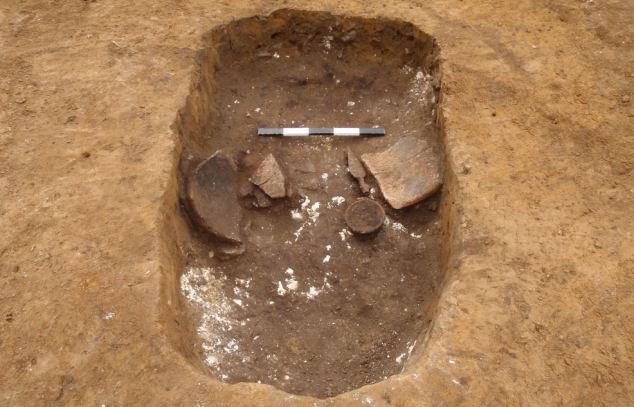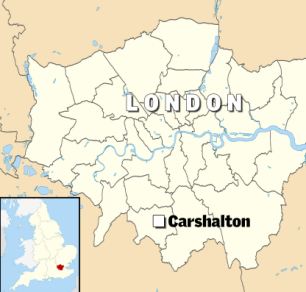The remains of Iron Age humans and their animal sacrifices has been unearthed at the construction site of a new school in south west London.
Amongst the 2,000-year-old remains found at the site in Carshalton is that of a horse found curled up at the bottom of a ditch.
Experts believe the area was once a small farming community made up of earth and timber roundhouses with thatched roofs.
London, now the largest urban area in the EU, was founded by the Romans in about the year 43AD.
A large number of other skeletons of domestic animals has been discovered, including horses, cattle, pigs, sheep, goats and dogs.
Iron Age human and sacrificial animal remains found on site of new school
By Daily Mail Reporter
16th September 2010
Daily Mail
Lying curled up at the bottom of a ditch, this horse had been sacrificed by early Britons almost 2,000 years ago.
Its Iron Age skeleton was unearthed alongside buried children and other animals during the construction of a new school.
Archaeologists have traced numerous finds, in Carshalton, south-west London, to the Iron Age and Roman era.

Horse remains that are more than 2,000 years old which were discovered during the construction of a new a school in Carshalton, south-west London
Experts, who said it was one of the most important finds in the capital in recent years, believe the area was once a small farming community made up of earth and timber roundhouses with thatched roofs.
The discoveries were made by workmen laying the foundations for the new Stanley Park High School on the former site of Queen Mary's Hospital.
Graham Tope, from Sutton Council, said: 'We are very excited to find such important examples of early life in Britain.
'Archaeologists tell us these excavations are certainly the most important ever undertaken in the London Borough of Sutton and very important in the context of Greater London where much of other evidence of these periods has been destroyed by earlier development.
'Building work for our super new school continues while careful excavations are carried out. We are keen to learn more about the artefacts and stories behind them after they have been fully analysed - it will really help to bring ancient history to life for local children when they attend their new school.'

Animal and human remains are painstakingly uncovered by archaeologists at the site

Tools discovered at the site which experts believe may have dated from the Iron Age
Duncan Hawkins, an archaeologist at the site, said: 'The archaeological remains are typical of a late Iron Age and early Roman farming settlement.
'A very large number of domestic animal skeletons have been recovered - including horses, cattle, pigs, sheep, goats and dogs.

The find was in south-west London
'These animals which were either whole or partly dismembered appear to have been deliberately sacrificed and deposited in deep (up to 4m) pits cut into the chalk bed rock.
'This may represent some form of 'closure' ritual when the settlement passed out of use with the pits perhaps originally representing grain stores.'
The site lies less than 100m from one of the largest late Bronze Age hilltop enclosures in south-east England, discovered during the construction of a hospital in the early 20th century.
Iron Age features, including a possible livestock pathway, shallow gullies and pits have also been identified.
The school intends to share the discoveries with the pupils to be used for inspiration in history lessons, the authority said.
dailymail.co.uk
Amongst the 2,000-year-old remains found at the site in Carshalton is that of a horse found curled up at the bottom of a ditch.
Experts believe the area was once a small farming community made up of earth and timber roundhouses with thatched roofs.
London, now the largest urban area in the EU, was founded by the Romans in about the year 43AD.
A large number of other skeletons of domestic animals has been discovered, including horses, cattle, pigs, sheep, goats and dogs.
Iron Age human and sacrificial animal remains found on site of new school
By Daily Mail Reporter
16th September 2010
Daily Mail
Lying curled up at the bottom of a ditch, this horse had been sacrificed by early Britons almost 2,000 years ago.
Its Iron Age skeleton was unearthed alongside buried children and other animals during the construction of a new school.
Archaeologists have traced numerous finds, in Carshalton, south-west London, to the Iron Age and Roman era.

Horse remains that are more than 2,000 years old which were discovered during the construction of a new a school in Carshalton, south-west London
Experts, who said it was one of the most important finds in the capital in recent years, believe the area was once a small farming community made up of earth and timber roundhouses with thatched roofs.
The discoveries were made by workmen laying the foundations for the new Stanley Park High School on the former site of Queen Mary's Hospital.
Graham Tope, from Sutton Council, said: 'We are very excited to find such important examples of early life in Britain.
'Archaeologists tell us these excavations are certainly the most important ever undertaken in the London Borough of Sutton and very important in the context of Greater London where much of other evidence of these periods has been destroyed by earlier development.
'Building work for our super new school continues while careful excavations are carried out. We are keen to learn more about the artefacts and stories behind them after they have been fully analysed - it will really help to bring ancient history to life for local children when they attend their new school.'

Animal and human remains are painstakingly uncovered by archaeologists at the site

Tools discovered at the site which experts believe may have dated from the Iron Age
Duncan Hawkins, an archaeologist at the site, said: 'The archaeological remains are typical of a late Iron Age and early Roman farming settlement.
'A very large number of domestic animal skeletons have been recovered - including horses, cattle, pigs, sheep, goats and dogs.

The find was in south-west London
'These animals which were either whole or partly dismembered appear to have been deliberately sacrificed and deposited in deep (up to 4m) pits cut into the chalk bed rock.
'This may represent some form of 'closure' ritual when the settlement passed out of use with the pits perhaps originally representing grain stores.'
The site lies less than 100m from one of the largest late Bronze Age hilltop enclosures in south-east England, discovered during the construction of a hospital in the early 20th century.
Iron Age features, including a possible livestock pathway, shallow gullies and pits have also been identified.
The school intends to share the discoveries with the pupils to be used for inspiration in history lessons, the authority said.
dailymail.co.uk